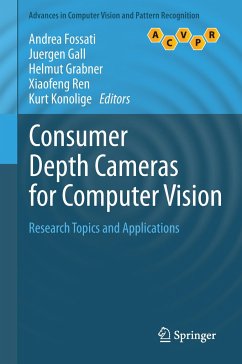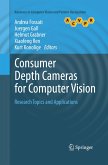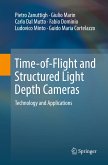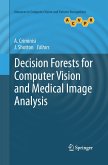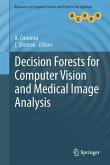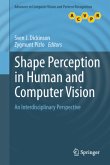The launch of Microsoft s Kinect, the first high-resolution depth-sensing camera for the consumer market, generated considerable excitement not only among computer gamers, but also within the global community of computer vision researchers.
The potential of consumer depth cameras extends well beyond entertainment and gaming, to real-world commercial applications such virtual fitting rooms, training for athletes, and assistance for the elderly. This authoritative text/reference reviews the scope and impact of this rapidly growing field, describing the most promising Kinect-based research activities, discussing significant current challenges, and showcasing exciting applications.
Topics and features: presents contributions from an international selection of preeminent authorities in their fields, from both academic and corporate research; addresses the classic problem of multi-view geometry of how to correlate images from different viewpoints to simultaneously estimate camera poses and world points; examines human pose estimation using video-rate depth images for gaming, motion capture, 3D human body scans, and hand pose recognition for sign language parsing; provides a review of approaches to various recognition problems, including category and instance learning of objects, and human activity recognition; with a Foreword by Dr. Jamie Shotton of Microsoft Research, Cambridge, UK.
This broad-ranging overview is a must-read for researchers and graduate students of computer vision and robotics wishing to learn more about the state of the art of this increasingly hot topic. The potential of consumer depth cameras extends well beyond entertainment and gaming, to real-world commercial applications. This authoritative text reviews the scope and impact of this rapidly growing field, describing the most promising Kinect-based research activities, discussing significant current challenges, and showcasing exciting applications. Features: presents contributions from an international selection of preeminent authorities in their fields, from both academic and corporate research; addresses the classic problem of multi-view geometry of how to correlate images from different viewpoints to simultaneously estimate camera poses and world points; examines human pose estimation using video-rate depth images for gaming, motion capture, 3D human body scans, and hand pose recognition for sign language parsing; provides a review of approaches to various recognition problems, including category and instance learning of objects, and human activity recognition; with a Foreword by Dr. Jamie Shotton.
The potential of consumer depth cameras extends well beyond entertainment and gaming, to real-world commercial applications such virtual fitting rooms, training for athletes, and assistance for the elderly. This authoritative text/reference reviews the scope and impact of this rapidly growing field, describing the most promising Kinect-based research activities, discussing significant current challenges, and showcasing exciting applications.
Topics and features: presents contributions from an international selection of preeminent authorities in their fields, from both academic and corporate research; addresses the classic problem of multi-view geometry of how to correlate images from different viewpoints to simultaneously estimate camera poses and world points; examines human pose estimation using video-rate depth images for gaming, motion capture, 3D human body scans, and hand pose recognition for sign language parsing; provides a review of approaches to various recognition problems, including category and instance learning of objects, and human activity recognition; with a Foreword by Dr. Jamie Shotton of Microsoft Research, Cambridge, UK.
This broad-ranging overview is a must-read for researchers and graduate students of computer vision and robotics wishing to learn more about the state of the art of this increasingly hot topic. The potential of consumer depth cameras extends well beyond entertainment and gaming, to real-world commercial applications. This authoritative text reviews the scope and impact of this rapidly growing field, describing the most promising Kinect-based research activities, discussing significant current challenges, and showcasing exciting applications. Features: presents contributions from an international selection of preeminent authorities in their fields, from both academic and corporate research; addresses the classic problem of multi-view geometry of how to correlate images from different viewpoints to simultaneously estimate camera poses and world points; examines human pose estimation using video-rate depth images for gaming, motion capture, 3D human body scans, and hand pose recognition for sign language parsing; provides a review of approaches to various recognition problems, including category and instance learning of objects, and human activity recognition; with a Foreword by Dr. Jamie Shotton.
From the reviews:
"Consumer Depth Cameras for Computer Vision is among the first few written from a research point of view. It is based on research published in the Workshop on Consumer Depth Cameras and includes some of the notable researchers in the field and the original team behind Kinect itself. It's an excellent resource for researchers working in computer vision and robotic vision or for students having knowledge of vision who wish to start working with Kinect. ... highly recommend this book to any researcher of Kinect." (Owais Mehmood, IAPR Newsletter, Vol. 35 (3-2), July, 2013)
"Consumer Depth Cameras for Computer Vision is among the first few written from a research point of view. It is based on research published in the Workshop on Consumer Depth Cameras and includes some of the notable researchers in the field and the original team behind Kinect itself. It's an excellent resource for researchers working in computer vision and robotic vision or for students having knowledge of vision who wish to start working with Kinect. ... highly recommend this book to any researcher of Kinect." (Owais Mehmood, IAPR Newsletter, Vol. 35 (3-2), July, 2013)

